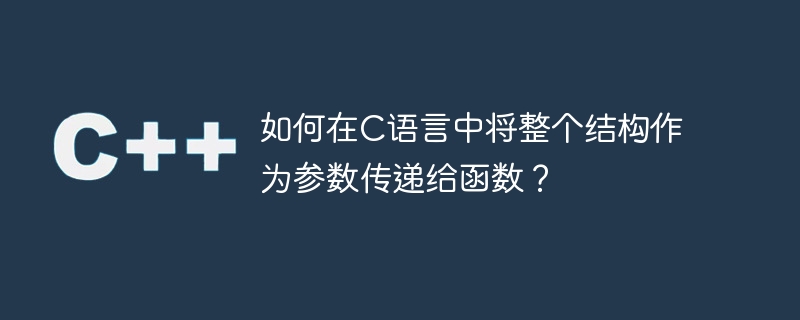

Il existe trois façons de transmettre la valeur d'une structure d'une fonction à une autre. Ils ressemblent à ceci :
Passer un seul membre en paramètre à une fonction.
Passez la structure entière en paramètre à la fonction.
Passez l'adresse de la structure en paramètre à la fonction.
Voyons maintenant comment passer la structure entière en paramètre à une fonction.
Donnez le nom de la variable de structure en argument dans l'appel de la fonction.
Collectez-le dans une autre variable de structure dans l'en-tête de la fonction.
L'inconvénient est que cela gaspille de la mémoire et crée à nouveau une copie de la structure entière.
Le programme suivant montre comment transmettre une structure entière en tant que paramètre à une fonction.
Démonstration
#include<stdio.h>
struct date{
int day;
char month[10];
int year;
};
int main(){
struct date d;
printf("enter the day,month and year:");
scanf("%d%s%d",&d.day,d.month,&d.year);
display(d);//passing entire structure as an argument to function
return 0;
}
void display(struct date d){
printf("day=%d</p><p>",d.day);
printf("month=%s</p><p>",d.month);
printf("year=%d</p><p>",d.year);
}Lorsque le programme ci-dessus est exécuté, il produit le résultat suivant −
enter the day, month and year:18 JAN 2021 day=18 month=JAN year=2021
Considérons un autre exemple, dans cet exemple, il est expliqué comment un programme C prend une structure entière comme paramètre passé à la fonction.
Démo en ligne
#include<stdio.h>
//Declaring structure//
struct add{
int var1;
int var2;
}a;
//Declaring and returning Function//
void show(struct add a){
//Declaring sum variable//
int sum;
//Arithmetic Operation//
sum=a.var1+a.var2;
//Printing O/p//
printf("Added value is %d",sum);
}
void main(){
//Declaring structure//
struct add a;
//Reading User I/p//
printf("Enter variable 1 = ");
scanf("%d",&a.var1);
printf("Enter variable 2 = ");
scanf("%d",&a.var2);
//Calling function//
show(a);
}Lorsque le programme ci-dessus est exécuté, il produit le résultat suivant −
Enter variable 1 = 20 Enter variable 2 = 50 Added value is 70
Il s'agit d'un autre programme C qui démontre la méthode de transmission de la structure entière en tant que paramètre à une fonction , où la déclaration des structures, la déclaration et le retour des fonctions, etc. sont expliquées.
Démo en ligne
#include<stdio.h>
//Declaring structure//
struct student{
int s1,s2,s3;
}s[5];
//Declaring and returning Function//
void addition(struct student s[]){
//Declaring sum variable and For loop variable//
int i,sum;
//Arithmetic Operation//
for(i=1;i<4;i++){
sum=s[i].s1+s[i].s2+s[i].s3;
printf("Student %d scored total of %d</p><p>",i,sum);
}
}
void main(){
//Declaring variable for For loop//
int i;
//Reading User I/p through For loop//
for(i=1;i<4;i++){
printf("Enter marks for student %d in subject 1 = ",i);
scanf("%d",&s[i].s1);
printf("Enter marks for student %d in subject 2 = ",i);
scanf("%d",&s[i].s2);
printf("Enter marks for student %d in subject 3 = ",i);
scanf("%d",&s[i].s3);
}
//Calling function//
addition(s);
}Lorsque le programme ci-dessus est exécuté, il produit les résultats suivants −
Enter marks for student 1 in subject 1 = 25 Enter marks for student 1 in subject 2 = 89 Enter marks for student 1 in subject 3 = 45 Enter marks for student 2 in subject 1 = 12 Enter marks for student 2 in subject 2 = 45 Enter marks for student 2 in subject 3 = 89 Enter marks for student 3 in subject 1 = 12 Enter marks for student 3 in subject 2 = 78 Enter marks for student 3 in subject 3 = 12 Student 1 scored total of 159 Student 2 scored total of 146 Student 3 scored total of 102
Ce qui précède est le contenu détaillé de. pour plus d'informations, suivez d'autres articles connexes sur le site Web de PHP en chinois!
 Nom des variables en langage C
Nom des variables en langage C
 Auto-apprentissage pour débutants en langage C sans fondement
Auto-apprentissage pour débutants en langage C sans fondement
 Ordre de priorité des opérateurs en langage C
Ordre de priorité des opérateurs en langage C
 Structure de données en langage C
Structure de données en langage C
 Utilisation des fonctions aléatoires du langage C
Utilisation des fonctions aléatoires du langage C
 utilisation du langage c const
utilisation du langage c const
 Utilisation de la fonction get en langage C
Utilisation de la fonction get en langage C
 méthode d'initialisation du tableau c
méthode d'initialisation du tableau c